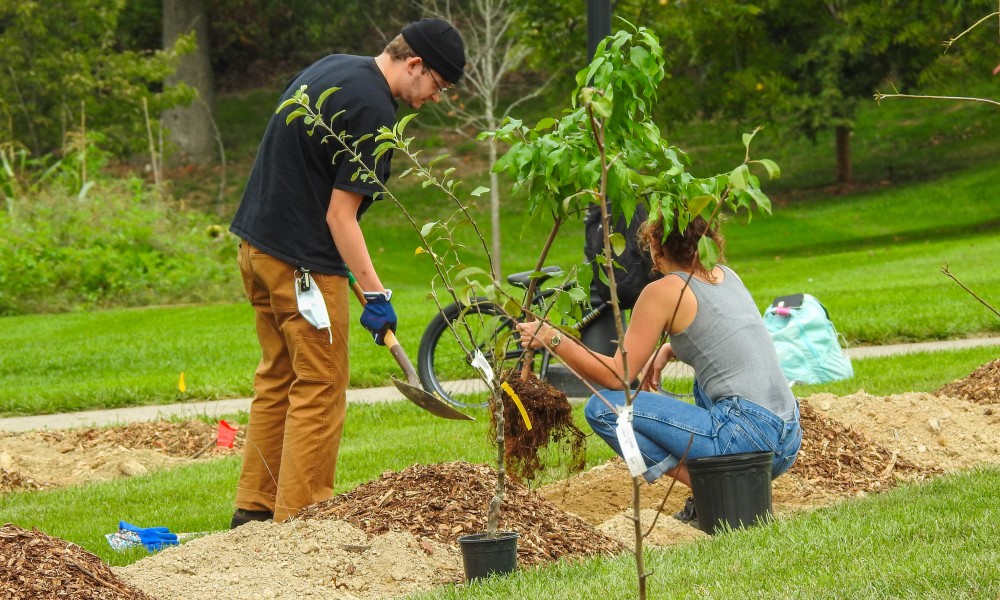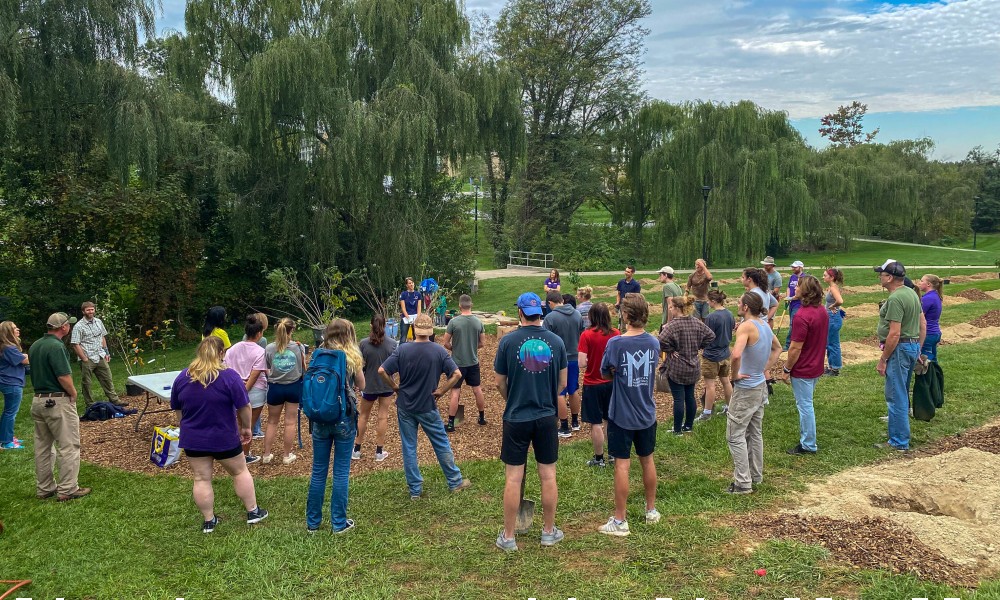JMU’s edible food forest offers unique and innovative learning opportunities
News
SUMMARY: JMU’s Edible Forest Garden offers unique and innovative learning opportunities while enhancing awareness of sustainable food production and whole food nutrition. It will expand pollinator habitats, restore marginal soils, improve localized nutrient cycling, enhance biodiversity, and provide local produce to the campus and community.
By Haley Huchler and Lynn Radocha
Imagine a campus with classrooms where students can learn and connect in outdoor spaces to gain first-hand knowledge and experience in agriculture and sustainability. This is what Mikaela Schmitt-Harsh, biologist and professor of Interdisciplinary Liberal Studies, envisioned when she brought the concept of an edible food forest garden to JMU.
An edible food forest garden is an ecosystem of plants that imitates the patterns of a natural forest. Located on the east campus, the JMU Edible Food Forest Garden is a step toward improving biodiversity and thinking about local food production.
“The food forest landscape not only provides food that is local and nutritious, but also rethinks how we can utilize the landscape more sustainably,” explains Schmitt-Harsh.
Integrated science and technology professor Wayne Teel has been a supporter of the EFG since its inception. He believes that JMU’s outdoor classrooms are just as crucial as indoor classrooms. “It should be more than just mowed grass,” says Teel. The food forest is the next step in utilizing JMU’s landscape for more than just getting from point A to point B.
“Having a food forest on campus is a way to provide students with knowledge of food production without them having to step off-campus,” explains Teel. “We bring the agriculture to the students, rather than taking the students to the agriculture.”
Schmitt-Harsh has been working on the project since 2020 – designing and marketing the EFG and creating partnerships within JMU and the Harrisonburg community. Finally, on October 15, 2021, she brought the EFG to fruition. Faculty, students and the community came together to plant approximately 100 fruit-producing and nitrogen-fixing trees and shrubs. “We deliberately planted in the fall because it gives trees an extra growing season before the stresses of summer,” explains Schmitt-Harsh. “The trees go dormant for a while and expend most of their energy to establish their roots. A healthy, well-established root system goes a long way toward ensuring vigorous growth in the spring and will hopefully increase the trees’ chance of survival in warm, dry summers.”

Now that the trees are in the ground, the primary caretakers of the food forest are Schmitt-Harsh and Kyle Snow, lab coordinator for the School of Integrated Sciences. Biology and ISAT students helped Schmitt-Harsh and Snow with maintenance and planning – staking and installing fencing around the fruit trees to protect them from deer.
The EFG is planted in a trios design - alternating fruit trees and nitrogen fixers. Nitrogen fixers are plants that contribute the essential plant nutrient nitrogen to the soil, aiding other plants around them. “Adding nitrogen fixers in with the fruit trees is intended to help improve nutrient cycling as well as slow the spread of pests,” explains Snow. “The trios design presents a great research opportunity for our students and faculty.”
The trees will produce a variety of common fruits – from apples and apricots to lesser-known fruits like persimmons and jostaberries. However, it may take three to five years before the trees bear fruit. “Most fruits that develop in the first two years will be removed so that the trees put more energy into vegetative growth,” explains Schmitt-Harsh. Heavy fruits (even if small) can stress young branches that haven’t fully developed. So even though one of the aims is to produce fruit, we'll have to be a bit patient about the timing of fruiting. When the trees do start to bear productively, it’ll be an exciting time – students can harvest fruits for the dining halls, campus pantry, personal consumption or for the community.”
Although the food forest is currently made up of trees, Schmitt-Harsh plans to introduce other woody shrubs, groundcover, herbs, and vines. The EFG also contains 18 ash stumps donated by the City of Harrisonburg. These stumps provide seating for students who may come to use the EFG as an outdoor classroom. Schmitt-Harsh hopes the food forest will present opportunities for engagement between JMU and the local community. “I’d like to eventually invite K-12 classes to use the EFG to learn about food forestry.”
ISAT majors Jason Darling (’22) and Lizzie Emch (’22) participated in the tree-planting event. “It was an educational experience as well as a memorable one,” says Emch. “It’s exciting to leave something on campus and come back a few years later hopefully see it grow and flourish.” Darling is passionate about projects like the food forest that could help mitigate the effects of climate change. “It’s probably not going to stop climate change, but adding trees and other native vegetation have numerous benefits,” explains Darling.
“I think students are interested and would like to see the transformation of campus in different ways,” says Schmitt-Harsh. “Every Friday that I’m there, students stop in and ask how they can get involved in the project.”
Get involved or find out more about JMU’s East Campus Food Forest
